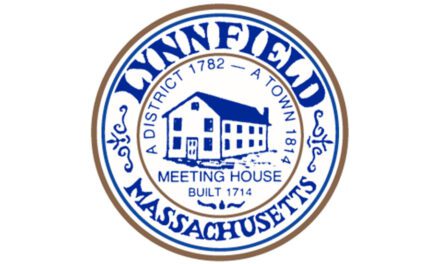By MAUREEN DOHERTY
LYNNFIELD — Fire Chief Mark Tetreault unveiled a completely revamped staffing plan for his department during his budget presentation to the selectmen Feb. 23. Tetreault believes his plan will reduce the strain currently placed on his department due to rising call volume while improving the average response time to emergencies.
The selectmen, however, expressed doubt that Tetreault’s entire plan could be implemented in time for the FY’16 budget cycle.
Tetreault explained that the town’s current combination business model is outmoded with today’s families. It consists of a full-time career force that covers the town’s two stations during the day, five days a week and relies on staffing callbacks with members of both the career force and the call firefighting force during the overnight hours.
When it was adopted in 1971, both parents typically did not work outside the home, he said, and the town staffed the South Fire Station with two firefighters and headquarters in the town center with three firefighters. Nearly 45 years later, the only staffing change on the career force has been the addition of a third firefighter at the South station during the day shift, he said. Meanwhile, the number of hours of training required for a call firefighter has increased dramatically, with over 500 hours for basic training and upward of 1,700 hours for a variety of additional training.
Tetreault said it is a credit to the current call and career firefighting force that they’ve been able to maintain this combination system for longer than any other area departments. In fact, it was difficult for him to find comparable towns who still rely so heavily on their call force. If changes are not made, however, he warned that the call firefighter system is in danger of fading away here.
Today, just over half of the callbacks on alarms are staffed by the career force with the call firefighters picking up the rest, he said.
“Most Fire Departments in the area embrace the career business plan. Most departments are full time and have people on duty 24 hours a day, seven days a week. To do that would cost the town $1.5 million just in salaries alone,” Tetreault said. He was not proposing the town make that dramatic a leap.
“Today most families are dual income, life is much more hectic and (families) have after school activities and sports,” the chief said, adding, “People are juggling child care responsibilities so even if they’re home sometimes they can’t come to a fire call or an ambulance call because they’re taking care of the kids. And it’s very rare that employers would allow their employees to leave to go to an emergency call.”
This is not unique to Lynnfield, he said, as firefighter recruitment and retention is reported as a problem nationwide. This is one reason he is committed to developing the Explorers program, which introduces teens ages 14-18 to the fire service. Tetreault said that he entered the fire service as an Explorer in high school, then became a call firefighter and eventually made it his career.
Response times increasing
In Lynnfield, response times to calls has increased each year since 2011, when the average was 7.42 minutes, to the low 8’s in 2012 and 2013 and then 9.27 minutes in 2014. If the current trend continues, Tetreault said the average response time for 2015 could climb to 9.88 minutes. He believes it is unacceptable to keep someone waiting that long for a fire truck or an ambulance.
At the same time, call volume has risen each year. In 2012, the department responded to 1,358 calls. That increased to 1,426 in 2013 and 1,667 in 2014. Tetreault said the projection for 2015 is 1,728 calls.
Increasingly, the fire and EMS departments are also responding to simultaneous calls more often. In 2011, there were 87 overlapping calls. The volume increased in 2012 to 145 and rose slightly in 2013 to 151 calls. But in 2014, that figure jumped to 218 and the current trend has Tetreault predicting 282 simultaneous calls in 2015.
While MarketStreet has had an impact, with the fire department averaging one call a day there, Tetreault said the increased volume of calls cannot be entirely attributed to that development. A big factor remains the growing number of senior citizens who also rely on his department for emergency calls and ambulance runs and the town has grown.
Hybrid plan
Under Tetreault’s hybrid plan, he would increase career staffing to provide on-duty coverage 12 hours per day, from 6 a.m. to 6 p.m., seven days a week while maintaining a full complement of 32 call firefighters and developing a “platoon system” for call firefighter staffing.
To accomplish this, he would add six “full-time equivalent” positions on the fire department comprised of two new career firefighters plus two call firefighters hired on a rotating basis to fill a day shift each day.
He said this system would ensure that firefighters provided the town with on-duty coverage 50 percent of the time, which would cover 67 percent of the daily incidents.
Tetreault said the cost of hiring six new career firefighters would be $490,000 but by utilizing this hybrid system the cost would be reduced to $288,000, which is a savings of $239,000.
To ensure that experienced career firefighters were paired with the new hires and the rotating call firefighters, Tetreault proposes two working groups. Group 1 would consist of Engine 1 covered by an experienced career firefighter (Alexander), a new career hire and a call firefighter, plus Engine 2 with two experienced career firefighters (Mutti, Ripley) and a call firefighter. Group 2 would be configured in the same fashion with a different slate of firefighters. Engine 1 would be covered by an experienced career firefighter (Walsh), a new career hire and a call firefighter, plus Engine 2 with two experienced career firefighters (Lyons, Diorio) and a call firefighter.
By integrating the call force into daily operations of the department, Tetreault said the call company benefits from more consistent hours and exposure to a variety of incidents and a reduction in callbacks, reducing stress “and ultimately preserves the call company.”
He said this hybrid plan also “more evenly distributes overtime for our career staff” while addressing increased service demands, decreasing response times and meets recommendations in the 2009 consultant’s report on the department’s operations by helping the system evolve.
Tetreault would also like to have two ambulances in service overnight rather than just one, with EMT staff working three days on followed by three days off.
Budget would increase 22.6 percent
The total fire budget, including the changes proposed and a variety of other department needs, is proposed by Tetreault at $1,412,306, which is a 22.6 percent increase over the FY’15 budget of $1,150,605. The staffing changes would result in about a 15 percent budget increase over last year, he said.
Selectmen Chairman Dave Nelson asked Tetreault if he was looking to implement the plan all at once or incrementally. Tetreault said it would be best to implement it all at once, especially considering the requirement of renegotiating with the firefighters’ union.
Tetreault said he has presented his plan to officers and the union and based on the feedback he received, “the majority of the firefighters are on board. Some are nervous but even the people who do not like this plan say we need to do something.”
Nelson said this issue has come up over the years. “This is a big deal. The reason I am bringing it up is it may not go ahead all at once,” the chairman said.
Tetreault said, “I really feel this is where we need to get. It is critical to do something.”
Selectman Phil Crawford said, “As much as I am for public safety we have to take a good, long look at this. There are a lot of comparisons to other communities (and) it is a little deceiving because there is nothing comparable” to Lynnfield’s current system.
Crawford suggested having one ambulance from a private company and using the town ambulance to handle the rising call volume. Tetreault said the town had used a private ambulance model in the past but it was not well-received so the town went back to providing this service.
“It costs $400 for every ambulance call and we generate $600 for every call,” he said, which is money the town loses when a private ambulance is used. Townspeople also lose the benefit of having “your friend and neighbor” assist them in their time of need, he said. “All of our firefighters and EMTs are cross trained,” he said, while a private ambulance service has strictly EMTs. He added that three of his call firefighters are currently attending paramedic school because they want to become career firefighters.
Crawford asked how many ambulance calls are “picked up by mutual aid?”
Tetreault cautioned against an overuse of mutual aid as it strains relations with those towns when they feel they are “providing a service to your community, not mutual aid.” Another downside to using mutual aid for ambulance service is the town has still sent a fire truck with personnel on board to the call to get aid to the scene and when another town’s ambulance handles the transport, the revenue goes to that town, not Lynnfield.
Regionalized dispatch service
Selectman Tom Terranova asked whether a “regional dispatch center could save us quite a bit of money” and if so, should it be considered.
“A regional call center makes sense to me but I am just one cog in the wheel,” Tetreault said, explaining that in New Hampshire’s Lakes Region he was involved in a dispatch center that handled 32 departments. “We have a lot more to consider here. The Police Department dispatches for the police, fire and ambulance.”
Police Chief Dave Breen stated during his subsequent presentation to the board that he disagrees with Tetreault on the benefits of regionalizing dispatch services because local control is lost.
Town Administrator Jim Boudreau said that because there would be so many parameters to develop on how this staffing plan would work, all of which would need to be agreed upon through collective bargaining by July 1, he did not think it was “something we can jump into for the FY’16 budget,” but added, “I definitely heard the chief that we need to get here.”
Boudreau recalled that 16 years ago when the Norwell call fire department was ended and the town went to full 24-hour coverage, every firefighter the town hired was a paramedic.
“We had a plan. We did it over time. We did not need to come up with $250,000 in one fiscal year. I think it will take more conversations with this board and the community to map out where we want to go and how we are going to get there,” Boudreau said.




